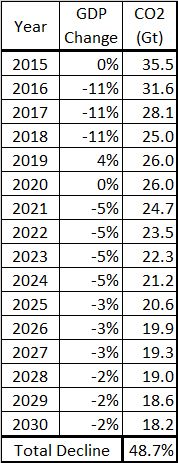We could reduce CO2 emissions 50% by 2030 without investing a single dollar [View all]
One of the interesting things about GDP is that making a dollar always requires the consumption of energy. And the consumption of energy (globally speaking) always entails the release of CO2. So it makes sense that if the world's GDP started to decline, CO2 emissions would decline as well.
Could the world's GDP start to slide? The likelihood is appearing greater all the time. Stock markets are slumping as commodity prices crash, China's economy is cratering, debt ratios around the world are soaring, and central banks appear to have run out the have run out of large-scale stimulus tools.
I decided to do a little thought experiment. What would happen to CO2 emissions if the world entered a depression similar to the Great Depression of the early 1930s, but somewhat longer-lasting?
I started with the key assumption that the CO2 intensity of GDP would remain constant over the period of the depression, so that the the percentage decline in CO2 emissions would track the percentage decline in GDP.
That initial assumption relies on an underlying assumption that the factors that have in the past reduced the carbon intensity of GDP (e.g. the renewable energy build-out and the increasing shift to service economies) would no longer be in play. Investment in new energy production facilities would stop, as they would no longer be needed; and the world would be too busy trying to survive to create more jobs in financial services and interior decorating.
I imagined a depression that began much like the Great Depression, with three years of low double-digit slides in GDP. this is followed by an attempted recovery that buys back some economic ground for a year or two, then a more gradual but long-lasting economic slide sets in, tapering off as 2030 approaches.
Here's what it looks like:

In this scenario, the steep economic slide begins next year, with three successive years of 11% declines in world GDP - about what the world experienced in 1929-1932. Those declines are followed by a year of recovery and a year of wide-eyed paralysis. After 2020 the longer, slower slide begins. It starts at 5% per year and gradually tapers off to 2% annual declines toward the end of the decade. Each year, CO2 emissions fall by the same percentage as the GDP.
By 2030, we would be emitting about half the CO2 we are today. This would happen without any requirement for renewable energy or nuclear power investments, and without the need for a single international agreement. Of course, GDP would have declined by half as well...
Now this is not a plan or a proposal. It's just a description of what would happen during an economic decline similar to one we have already experienced in the past.
Unlike the "extend-and-pretend" of the international climate conferences, or the wishful thinking of the renewable energy advocates, this process can be guaranteed to work. And a quick look at the stock, bond and commodity markets should tell you that the chance of it happening is actually fairly good.
So there is hope for the biosphere after all. 
